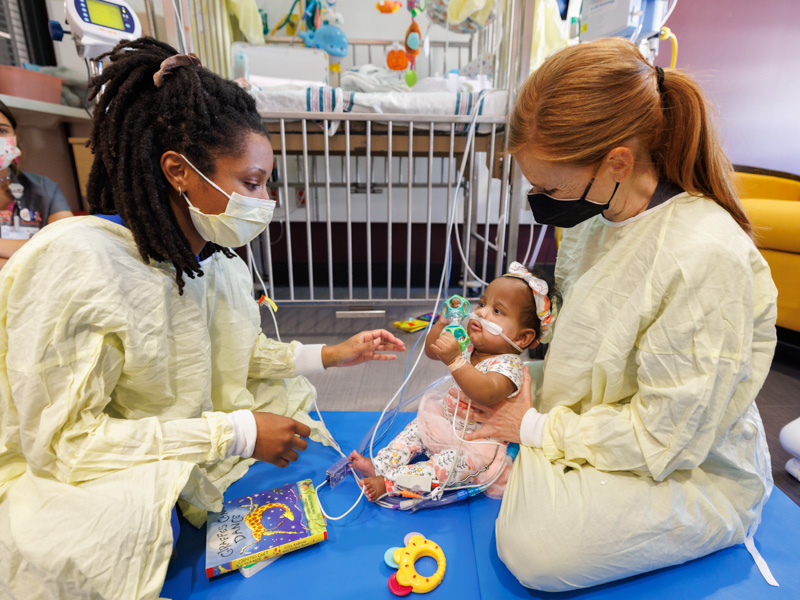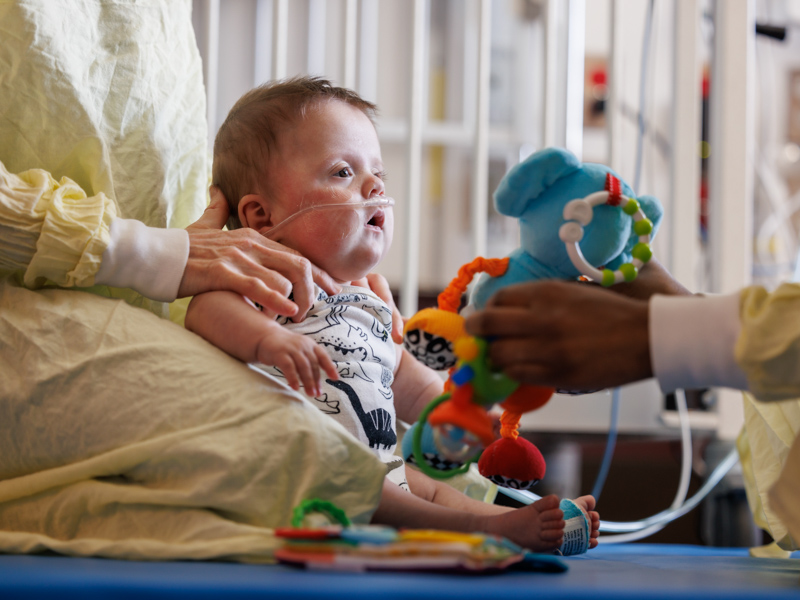
Room to Grow: Children's expansion gives NICU babies space for therapy
Published on Monday, August 8, 2022
By: Andrea Wright Dilworth
Note: This article originally appeared in the Summer 2022 issue of Under the Rainbow, the semi-annual magazine for Children's of Mississippi.
At least twice a week, 8-month-old A’Nyla Rai Stark meets with a physical therapist, occupational therapist and an early interventionist, who work as a team on a number of skills, which include helping her work on lifting her head, grabbing toys with her hands, following objects with her eyes and responding to their voices — skills that come more naturally to full-term babies.
In her single room of the Kathy and Joe Sanderson Tower at Children’s of Mississippi, A’Nyla Rai, born prematurely at just 25 weeks (more than three months early), and her therapists have the luxury of space and the absence of chaos and noise.
That was not the case in the old bay-style NICU, where each open pod held up to six newborns.
“The babies were side-by-side with a lot of stimulation coming at them every day in a very unnatural way,” said Elizabeth Woodcock, A’Nyla Rai’s physical therapist. “Their parents were never able to be alone with their baby. We never had a quiet place for teaching and learning to occur. It is very difficult to learn an activity to perform with your baby when there are so many distractions around you.

“Now we have an environment more conducive to developing relationships with our families, where we can interact without the distractions of medical interventions for other infants happening around us.”
Dr. Mobolaji Famuyide, professor and chief of the division of newborn medicine, said that family-centered approach enables the team to have parents as partners instead of as NICU visitors.
It also allows therapists to treat older, more chronic babies on therapy mats at floor level, typical of a home environment, said Iesha Smith, the pediatric occupational therapist who treats A’Nyla Rai.
“My patients are able to tolerate longer treatment sessions due to less negative and intrusive external stimuli,” said Smith. “Longer treatment sessions are beneficial because they allow for better carryover of learning.
“This allows a change of environment for those babies, as well as more freedom to move and explore their environments, which increases cognitive and visual stimulation. Previously, we were only able to treat our patients in their cribs or our laps, even if they were approaching or had surpassed 1 year old. This hindered the development of foundational gross motor skills, such as rolling and supported sitting.”
Therapy Is In Session
Smith and Woodcock pull out an ocean blue therapeutic mat, lay it in the middle of the floor, and gently seat A’Nyla Rai on it, the two therapists on either side of her.
When Smith dangles a blue and green wheel-shaped toy, the patient — with an oxygen tube flowing from her nose — grabs the toy, much to the delight of her therapists, who cheer her on. Today’s therapy also consists of tummy time activities to help her build strength, flexibility and control of her muscles.
“She’s come a long way,” said Kara Butler, an early interventionist in pediatrics, as she watches the trio’s patient like a proud teacher.
In addition to floor time, there’s room for seating babies in developmental equipment, like bouncy seats, swings and highchairs — without interfering with the nurses’ care or intruding on the space families use while visiting, Smith said.
A few doors down the hall in a room basking in sunlight, 3-month-old Londyn Logan, born at 35 weeks, is as vibrant as the Valentine’s hearts that adorn her red and white jumper. After tummy time and play time in her crib with Butler and Smith, in which her bright eyes follow everything in sight, it’s story time.

In a golden plush chair with baby on her lap, Butler animatedly reads “Brown Bear, Brown Bear” and “That’s Not My Unicorn” as Londyn scans the pages intently, convincing all watching that she understands the plot.
With no other babies or equipment competing for her attention, Londyn can focus on the book.
“Research suggests that stress can impact early brain development,” Butler explained, “so fostering an environment for our babies that reduces stress is imperative. Having private rooms where we can control lighting and noise allows for a healthier environment for our babies to grow and thrive.”
That parents have a place to sleep overnight beside their babies is another bonus of the new tower. Each room has a sofa and restroom with a shower, so parents can spend as much time with their babies as their schedules allow, a godsend since many live hours away, given this is the state’s only Level IV NICU.
When parents stay overnight, it also benefits therapists and other care providers, who can begin the educational journey of teaching them how to care for their babies long before they’re discharged, explained Smith.
Lene Turner can’t imagine not being able to stay overnight with 2-week-old Ja’Dyn, born three months early and weighing just 2 pounds and 14 ounces. Not only is she able to bond with her newborn, but she is learning how to reposition and calm him when he’s stressed.

Isolette babies make up at least half of the NICU population, said Katherine McAuley, an occupational therapist who works with the smaller babies, including Ja’Dyn, who require extra care from birth as they continue to grow and develop.
“My job when they’re in the isolette is mostly positioning,” said McAuley, as she reaches into the isolette where Ja’Dyn, connected to a breathing tube and monitors, cries, his tiny arms and legs stirring about. Seconds later, after she’s provided positioning support, he’s quiet and still. “Developmental positioning starts at birth. A premature baby doesn’t have good control of their muscles. The goal is to get them in the fetal position so they’re nice and supported.”
McAuley notes that Ja’Dyn’s calmness after repositioning demonstrates organized behavior and that he is not looking for containment, signs he is no longer stressed.
“As a caregiver, you want to be able to help your baby,” said Butler. “Katie is able to show them how they can touch and hold their babies in order to bring comfort and engagement.”


